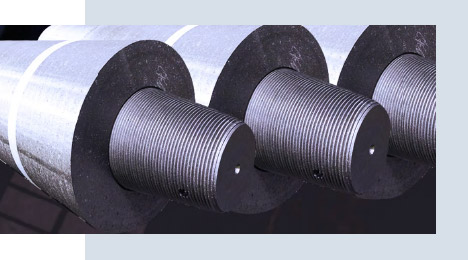Main uses of carbon and graphite
Traditional demand for natural graphite is largely tied to the steel industry where it is used as a component in bricks which line blast furnaces (“refractories”), as a liner for ladles and crucibles, and synthetic graphite in electrodes for the recycling of steel. In the automotive industry it is used in brake linings, gaskets and clutch materials. Graphite also has a myriad of other industrial uses in lubricants, carbon brushes for electric motors, fire retardants, and insulation and reinforcements products. Graphite is a very important part of everyday life but is rarely seen or heard of.


Graphite Electrodes
The largest end use for primary synthetic graphite is in the production of graphite electrodes. These can handle very high currents and are produced by moulding synthetic graphite to the correct shape directly after the graphite manufacture. Graphite electrodes are used mainly in electric arc furnaces (EAFs) for the production of steel, iron, and non-ferrous metals.

Refractories
Graphite additives are used in the production of refractory materials for high-temperature environments such as the linings for furnaces, kilns, incinerators and reactors. Refractories are the second-largest market for graphite after electrodes. Graphite is used to increase the effectiveness of the final refractory product by:
- Increasing thermal conductivity
- Decreasing thermal gradient between the hot and cold faces of the product, thereby reducing expansion
- Repelling molten slag
- Increasing working life of the product
- Increasing ability of the product to withstand
thermal shocks/corrosion thereby, improving performance at higher temperatures - Reducing wettability to molten metals so that they do not affect the end-product.
Batteries
Growth in the battery market continues to shape the graphite industry, underpinned by rapidly rising demand for both natural and synthetic graphite as an active anode material in lithium-ion batteries. Graphite is used in batteries to improve electrical conductance while remaining chemically inert and stable against corrosion. In lithium-ion batteries, graphite is a main constituent of the anode, acting as a host for the lithium ions. Graphite is also used in smaller amounts in other battery types, mainly as an electrically conductive additive. Fuel cells have taken an increasing part of the battery market. While traditional batteries only store electrical energy, fuel cells also have generation capability.

Lubricants


Recarburising
Carbon additives are introduced to some irons and steels, when in molten liquid form, to increase carbon content and to improve final performance. The process of adding carbon is referred to as recarburising, although it is also known as carburizing, carburization or carbon raising. The term recarburising also has a more specialist meaning within the industry – to replenish carbon lost during the manufacturing process. Carbon additives used for this purpose typically include mixtures of synthetic graphite, natural graphite, calcined petroleum coke, metallurgical coke, anthracite or similar materials.

Graphite shapes
Graphite can be easily machined into a variety of shapes. Graphite shapes are general terms used to describe solid, shaped graphite products used across many industries, often in elevated temperature applications. End users include the aerospace, automotive, industrial machinery and electronics industries.
Carbon fibre/fibre composites and graphite specialties
Today, composites and graphite-based solutions are playing a key role in automotive applications and will continue to do so in the future. Whether for body and main parts, powertrain, motor block or brake system: As a long-standing component and development partner to the automotive industry, we supply high-quality materials and components for both electric and non-electric mobility. Carbon fiber is significantly lighter than conventional materials. It is therefore obvious to increasingly use composite structures for component development. They reduce the weight of vehicles and thus ensure lower CO2 emissions.


